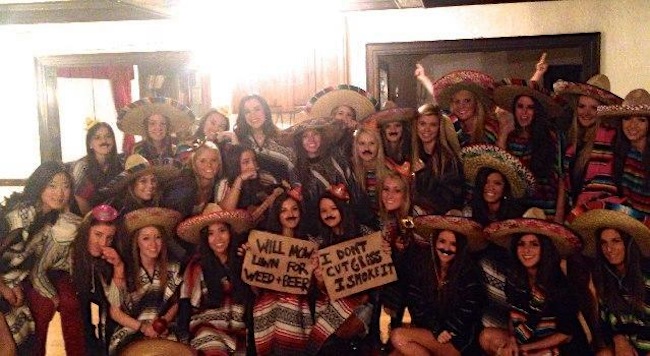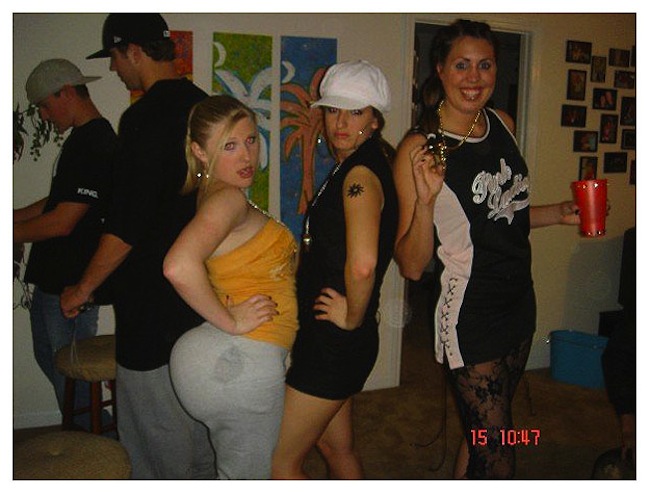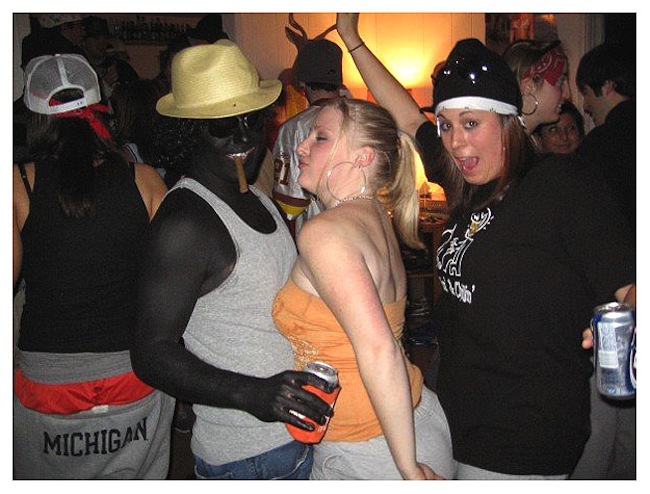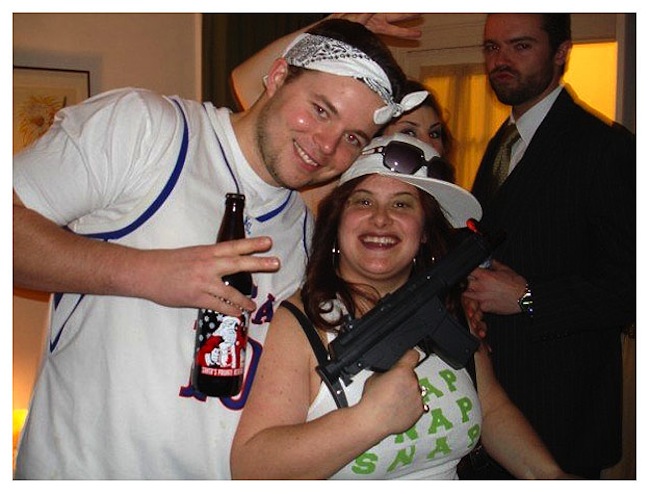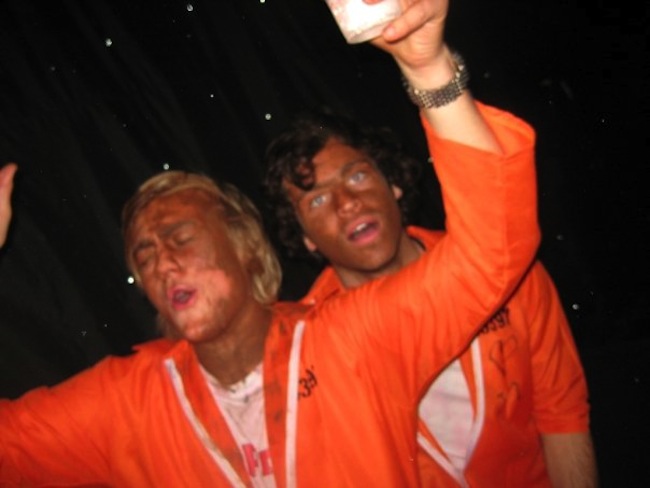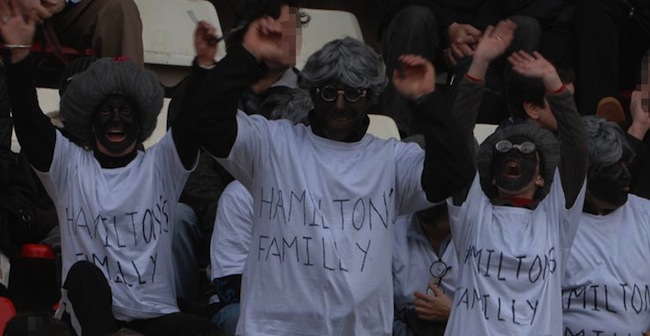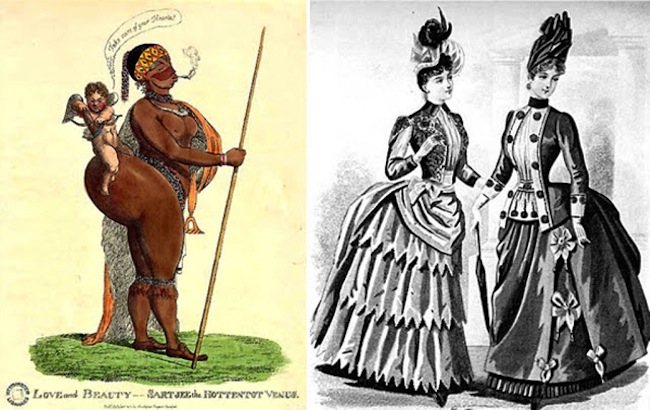Caroline Wozniacki is a racist? Is blacking up always wrong?
WAS it racist? Was Caroline Wozniacki’s impersonation of Serena Williams racist? We’d say it wasn’t. Williams has made fun of her own body shape. She brought up the size of her backside, so it’s fair game. Right? It’s all about intent and tone. In the post-Macpherson Report UK, of course, you can be unintentionally racist. If you think its racist, then it is. You can be an unwitting racist. He told us: “…any incident which is perceived to be racist by the victim or by any other person.”
So. Are these people racist (via)?
Members of the Chi Omega sorority at Penn State (source) at a Mexican fiesta-themed party around Halloween 2012. The signs read: “will mow lawn for weed & beer” and “I don’t cut grass I smoke it.”
The Vice President of the college’s Mexican American Student Association, Cesar Sanchez Lopez, wrote:
The Mexican American Student Association is disappointed in the attire chosen by this sorority. It in no way represents our culture. Not only have they chosen to stereotype our culture with serapes and sombreros, but the insinuation about drug usage makes this image more offensive. Our country is plagued by a drug war that has led to the death of an estimated 50,000 people, which is nothing to be joked about.
n September 2011 students at Hautes Etudes Commerciales, Montreal business school, wore “black makeup [and] chant[ing] with mock Jamaican accents about smoking marijuana” (source) to honour of Jamacian Olympian Usain Bolt.
Anthony Morgan, a law student at McGill University, wrote:
[Being black] is not a costume that you put on… This is not just about a few bad apples. This is about a greater problem about what we think about, how we value, how we understand, how we discuss — if we discuss — black history, culture and contribution.
Perhaps the pick of the bunch are these photos of a party in for Martin Luther King Day at Tarleton State University, Texas:
These images are from a party in “honor” of Martin Luther King Day at Clemson College, South Carolina:
A party in “honor” of Martin Luther King Day at University of Connecticut School of Law:
TheAthletics Union at the London School of Economics “dressed up as Guantanamo Bay inmates and drunkenly yelled ‘Oh Allah’…” Here:
Here’s Caroline Wozniacki:
Previously:
In 2008, Spanish F! fans taunt Lewis Hamilton:
Much earlier:
Two late 18th century images. The first shows a very racist and exaggeratedly depicted image of a Black Hottentot woman, with her buttocks especially exaggerated so that a small, White cherub can sit on them. Beside that image is an illustration of two white European women in very high class dresses with very large bustles creating the illusion of very extremely large rear ends. Southern Africa inspired European women in the 18th century to enhance their butts.
In 2009, Tory MP, Philip Davies wrote to Trevor Phillips, chairman of the Equality and Human Rights Commission:
“Is it offensive to black up or not, particularly if you are impersonating a black person?… why it is so offensive to black up your face, as I have never understood this”.
In 2007, a Tory named Emma Penreath posed for this photo on her Facebook page. The caption read: “Emma’s career in politics lies in tatters after she follows Ann Winterton’s lead and dresses as a ‘Nigger Minstrel’ for the Tory black and white Ball.”
Is it all racist? David Lister looks at the impact of blacking up in art:
At the very same time that it became unthinkable to consider a white actor playing Othello at, say, the National Theatre, down the road at the Royal Opera House, Placido Domingo, arguably the most famous opera singer in the world, would “black up” to play that same part in Verdi’s Otello, and not one single voice was ever raised in protest.
That, I would argue, was pretty strange. Does the fact that one is singing rather than speaking a part change the rules?
Yet the gradual disappearance of the derogatory “blackface” owed more to capitalist intuition than to top-down “anti-racist” initiatives. Film and television producers began to appreciate that audiences no longer felt comfortable with white people perpetuating racist caricatures. The custom has, however, continued – but its context has changed. Alec Guinness embellished his appearance necessarily when he played Prince Faisal in Lawrence of Arabia (1962), as did Ben Kingsley (who is half Kenyan-Indian anyhow) when he appeared as Gandhi in 1982. In The Conqueror (1956), John Wayne was an oriental Genghis Khan (admittedly, forgettably so). But these portrayals didn’t aim to perpetuate ethnic stereotypes. Guinness and Kingsley appeared not as faceless, generic Arabs or Indians (in contradistinction to the “browned-up” Kenneth Williams and Bernard Bresslaw in the 1968 film Carry on Up the Khyber), but as individual historical characters. Like Depardieu, they were cast in these roles to guarantee box-office success.
Is blacking up always wrong? Might it even be a form of empathy and admiration? The right-on, white anti-war dude sticks on a keffiyeh and becomes at one with the Arabs. If he “blacking up”?
Posted: 13th, December 2012 | In: Key Posts, Reviews Comment | TrackBack | Permalink


